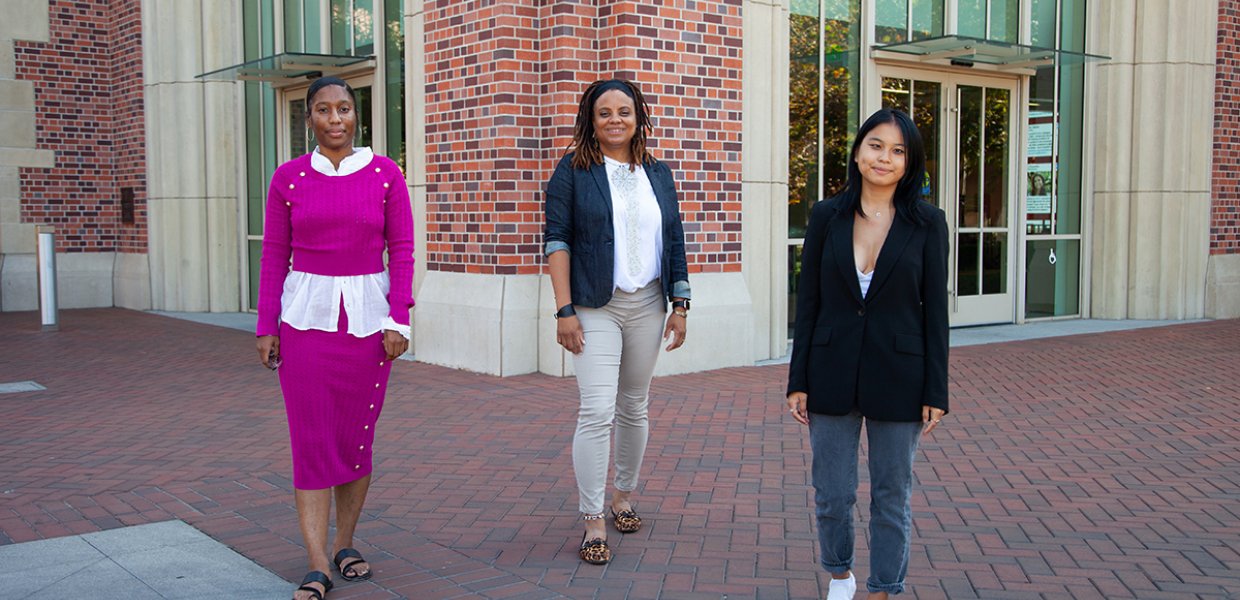Tasked with recording threats to mental and physical health in her South Los Angeles neighborhood, Samantha Reyes took note of small details — and the big picture.
Walking down Atlantic Avenue as part of a research project for USC Annenberg’s Health and Equity Media Collaborative, Reyes spotted a full syringe leaning up against the curb. She also noticed liquor stores and weed dispensaries on every corner. “Seeing these things just gets us thinking about what’s in our neighborhoods,” said Reyes, who is in her senior year at Manuel Dominguez High School in Compton. “You start to think, what does that mean to us, as teenagers, that we could possibly get alcohol and pot at our age because of its accessibility?” she said.
The high schooler was one of 24 young people brought on this past summer to work on various projects in the lab, which was founded by Robin Stevens in early 2021. Stevens, associate professor of communication, says she assembled an expert team of young researchers — specifically students of color — to eventually work on campus.
“We are doing community-engaged worked where we use and leverage technology and media for the health of young people,” said Stevens. “The LA Rise Digital Media Neighborhood” project gave me a window to look at LA through the eyes of young people.”
Reyes worked on this project under the direction of Essence Wilson, a second-year communication doctoral student on Stevens’ team.
“I really wanted to understand what affects the mental health landscape of students —adolescents — so we can we best design an intervention for them,” Wilson said.
The group gathered on Zoom over a five-week period starting in July to discuss what they found while surveying their neighborhoods.
While the students documented neighborhood stressors, including clear safety issues, Wilson notes that students found getting into college to be more prevalent stress points in their lives.
“I remember one student, she was talking about how she was in five different internships, she was concerned about not being in a club,” Wilson said. “All of the students kind of tacked on saying, ‘Yes, it’s hard. I have to do this; I have to take sports just to be a viable candidate for a school that may or may not accept me.’ It kind of resonated with me and is something that we are going to look at in terms of further research.”
This past summer, the lab also worked on a second project that grew from Stevens’ research at the University of Pennsylvania before she arrived at USC Annenberg in Fall 2020. Funded by The National Institutes for Health (NIH), in partnership with the University of Delaware, that project centered around sugar-sweetened energy beverages.
“The whole point is to teach high schoolers about energy drink consumption and the negative effects of it,” said Sydney Fiorentino, a sophomore in chemical engineering at USC Viterbi, who worked on the project.
Fiorentino had already taken a journalism course for non-majors at USC Annenberg, worked in the radio room at the media center and wrote for the Daily Trojan when she decided she wanted to look for research opportunities on the USC Annenberg website. “The word research is thrown around at USC and a lot of students are involved,” she said. “I wanted to see what it would be like.”
For this project, Fiorentino, along with Laura Broomell, a PhD student at the University of Delaware, along with eight high school students from the East and West coasts, created a manual about the negative effects of the drinks. They also designed TikTok and Instagram posts with that messaging.
One TikTok video they produced shows a young girl frantically running away from a text superimposed over the video that reads: “When you find out energy /sports drinks actually cause harm to the human body.”
“I want our lab to be a place where if you want to work with young people and you don’t have the ability to cultivate those relationships, I have an expert team ready to help,” Stevens said.
Stevens also hopes the center will help USC better serve its neighbors, adding, “Having their children learn here and become great researchers here will inspire people to feel like, ‘Maybe those fences aren’t to keep me out.’”
